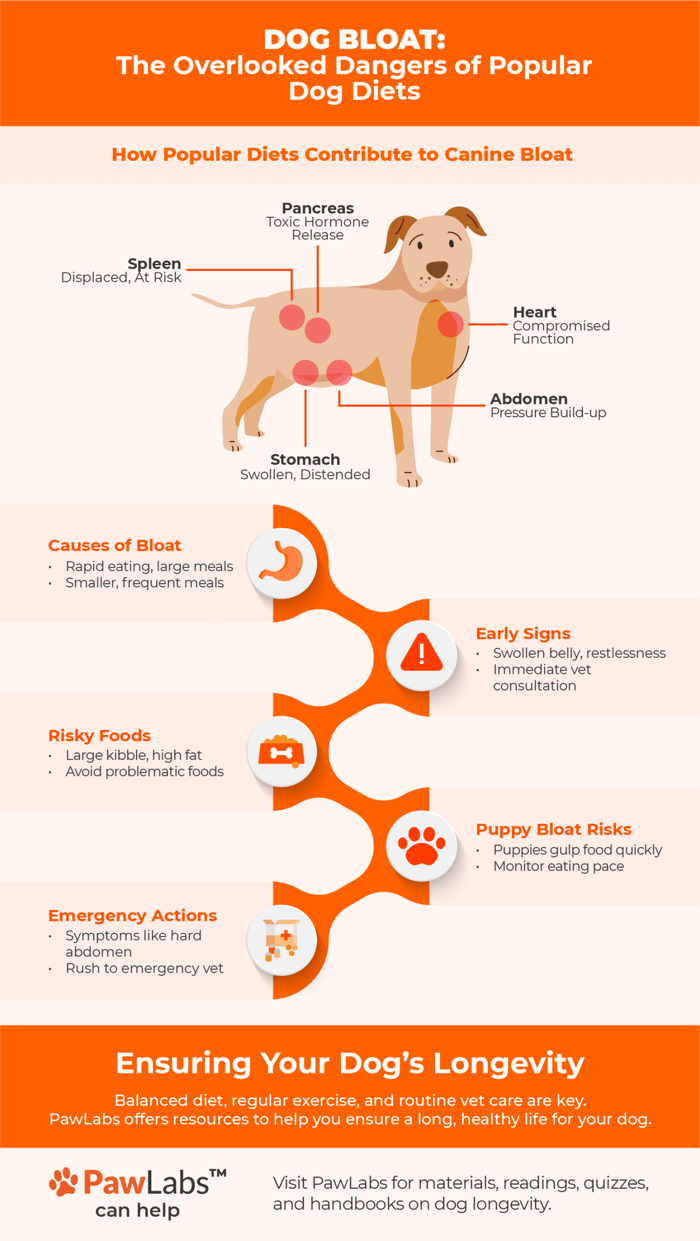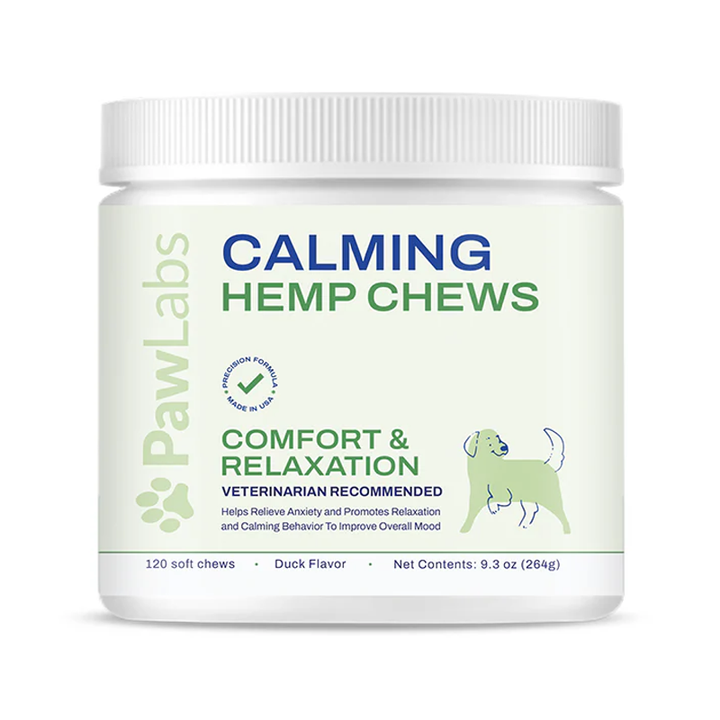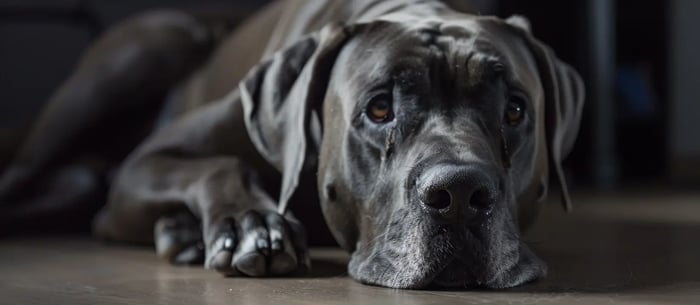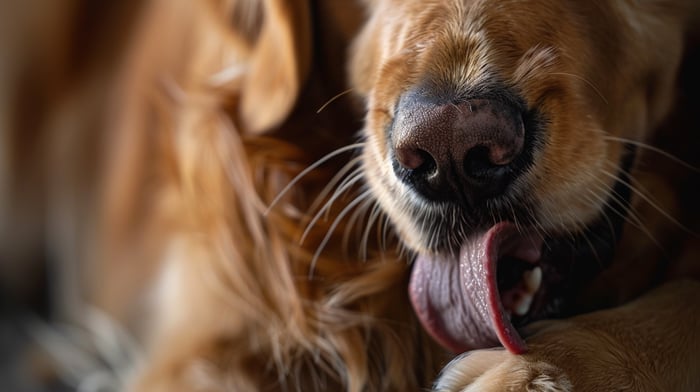Dog Bloat: The Overlooked Dangers of Popular Dog Foods and Diets
How Popular Diets Contribute to Canine Bloat

How Popular Diets Contribute to Canine Bloat
Dog bloat, or gastric dilatation-volvulus (GDV), is a serious condition that can have devastating effects on dogs. While commonly associated with large, deep-chested breeds, any dog can suffer from this life-threatening issue. In this blog, we'll explore how certain popular dog diets contribute to the risk of bloat, what signs to look out for, and how you can help prevent this condition in your beloved pet.

What is Dog Bloat and Why Should You Be Concerned?
Bloat, scientifically known as gastric dilatation-volvulus (GDV), is a rapid-onset medical emergency that occurs when a dog's stomach fills with gas and becomes twisted. The condition prevents blood from returning to the heart from the abdomen and hind legs, leading to shock and severe health complications. The twisting of the stomach can also drag along other organs like the spleen and pancreas, worsening the situation by cutting off their blood supply and causing toxic hormonal releases, particularly affecting the heart (American Kennel Club).
How Do Popular Dog Diets Contribute to Bloat in Dogs?

While the exact causes of dog bloat are not fully understood, dietary factors play a significant role. Feeding habits such as rapid eating, consuming a single large meal daily, and eating from raised food bowls have been associated with an increased risk of bloat. Diets that cause gas accumulation in the stomach, like those high in fermentable carbohydrates (certain grains and legumes), might contribute to the condition. It's crucial to consider not just what dogs eat, but also how and when they eat to manage bloat risk effectively (American Kennel Club) (AKC Canine Health Foundation).
Diets that encourage rapid eating or large single meals can contribute to bloat. Foods that induce excessive gas production or are ingested rapidly can increase the risk of the stomach distending and twisting (Canine Journal).
Certain dietary habits can increase the risk of dog bloat, such as feeding large meals once a day, using raised feeding bowls, or feeding dry foods that might encourage rapid eating. Moistening dry food, especially if it contains citric acid, has been shown to increase the risk of bloat (Great Pet Care).
What Are the Early Signs of Dog Bloat to Look For?

Early detection of dog bloat is critical. Signs to watch for include a noticeably swollen or hard abdomen, retching without vomit, excessive salivation, restlessness, and signs of pain such as whining when the belly is touched. These symptoms can rapidly progress to more severe conditions such as shock, characterized by weak pulse and pale gums (American Kennel Club) (Preventive Vet).
Can a Dog’s Stomach Flip Due to Certain Foods?
While specific foods haven't been definitively linked to causing the stomach to flip, feeding practices around those foods can increase the risk. Large quantities of food, particularly large kibble that absorbs water and expands in the stomach, can be problematic. Also, vigorous exercise right after eating can increase the likelihood of the stomach flipping (American Kennel Club) (AKC Canine Health Foundation).
While no specific foods are proven to cause the stomach to flip directly, behaviors associated with eating—such as gulping food quickly or exercising immediately after eating—can contribute to the likelihood of GDV (Canine Journal).
What Specific Ingredients Should Be Avoided to Prevent Canine Bloat?
To minimize the risk of dog bloat, avoid ingredients that produce excessive gas or delay gastric emptying. These include some legumes like soybeans, some vegetables like cauliflower, and high-fat diets that slow stomach turnover. Opt for easily digestible, high-quality proteins and adequate fiber content to promote normal digestion and reduce the risk of gas accumulation (American Kennel Club) (AKC Canine Health Foundation).
While there's no definitive list of ingredients that cause bloat, foods that increase gas production or encourage rapid eating should be avoided. This includes excessive grains in some kibbles, which can ferment during digestion and produce gas (Canine Journal) (Great Pet Care).
How Can Changing Your Dog’s Eating Patterns Reduce the Risk of Bloat Signs?

Modifying how and when your dog eats can significantly reduce the risk of bloat. Recommendations include feeding two to three smaller meals spread throughout the day instead of one large meal, discouraging rapid eating by using slow-feeder bowls, and avoiding exercise immediately before and after meals to allow proper digestion (American Kennel Club) (AKC Canine Health Foundation).
To mitigate the risk, feed multiple smaller meals throughout the day instead of one large meal, avoid vigorous exercise around meal times, and use slow-feeder bowls to prevent rapid eating (The Adored Beast Apothecary Blog) (EVH Emergency Vet Hospital).
Are Puppies More Susceptible to Bloat and What Are the Signs?
While bloat is more commonly observed in older large and giant breed dogs, puppies can be affected if they have predisposing factors such as a familial history of bloat. In puppies, watch for similar signs as in adult dogs, like distress, a swollen belly, and signs of pain. Early intervention is crucial, so recognizing these signs can be lifesaving (American Kennel Club) (AKC Canine Health Foundation).
Puppies are generally less susceptible to GDV compared to older dogs, but they are not immune. Rapid eating and excessive water intake post-meal can put them at risk. Signs are similar to those in adult dogs, including distress and abdominal swelling (Preventive Vet).
What Steps Should You Take if You Notice Signs of a Flipped Stomach in Your Dog?
If you suspect your pet has dog bloat, it is a medical emergency, and immediate veterinary care is necessary. Do not attempt to treat bloat at home. Signs of a flipped stomach require prompt surgical intervention to decompress the stomach and possibly tack it in place to prevent future incidents. Knowing the signs and acting quickly can save your dog's life (Preventive Vet).
Immediate veterinary care is crucial. Do not attempt home remedies as bloat requires professional treatment, often surgical, to decompress and reposition the stomach. Understanding the symptoms and acting swiftly can save your dog's life (Petful) (Dogster)
The Importance of Dog Longevity
Ensuring the longevity of our furry friends is not just about giving them a longer life, but about enhancing the quality of those extra years. Proper care, including managing risks like bloat, plays a crucial role in helping them lead a happy, healthy life. Here are a few ways that understanding and preventing bloat contributes to canine longevity:
- Prevention of emergencies: Understanding the risks and symptoms of bloat can prevent emergencies, reducing stress and potential harm.
- Promotion of good health practices: Regular vet visits and appropriate feeding practices promote overall health, catching potential issues early.
- Encouragement of a balanced diet: Feeding your dog a balanced diet that prevents bloat supports their digestive health and overall well-being.
Gut-Max Probiotic Chews

Calming Hemp Chews

$59.95
$69.90
7 Key Ingredient Formula: Hemp Seed Oil Hemp Seed Meal Chamomile Valerian Root Passion Flower Ginger Root L-Tryptophan … read more
 SUCCESS!
SUCCESS!






